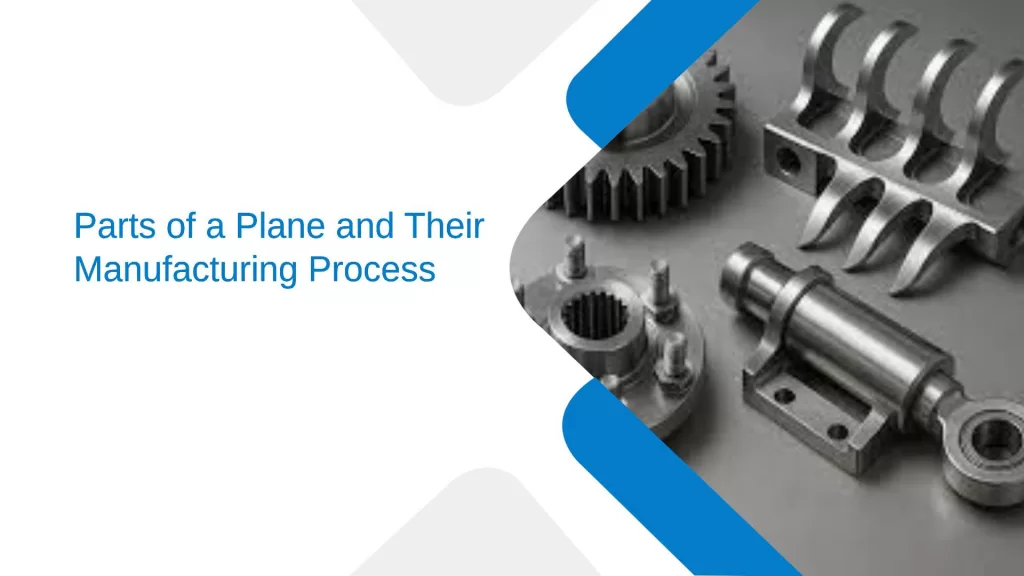Parts of a Plane and Their Manufacturing Process
- Aerospace, Industrial Engineering |
- Nov 4, 2025

One of the most advanced and precise areas of modern manufacturing is the aircraft industry. There are thousands of well engineered parts that make up any airplane from commercial jets to military drones. All these parts are designed to work together to keep the aircraft safe and efficient.
The airplane parts comply with some of the world’s toughest technical and quality standards. You might better grasp the advanced, high-tech nature of the aerospace sector by understanding the main elements of an aircraft and its manufacturing processes. Let us dive into the blog to know more about aerospace parts.
Major Airplane Parts
Aircraft are complex devices comprising numerous mechanical, electrical, and structural parts. In general, these parts may be divided into a few primary categories:
1. Fuselage: The main aircraft component that joins the wings and tail of an airplane is the fuselage. Its structure is lightweight yet very strong, able to withstand pressurization and distribute weight.
Nowadays, the fuselages are almost always constructed out of aluminium alloys or carbon fiber-based composites like carbon fibre-reinforced polymers. These substances reduce the aircraft’s weight while providing it with great strength and making it very fatigue-resistant.
2. Wings: The wings are the major aircraft component that produces the required lift. In addition to the outer cover, the wings consist of internal structures such as spars, ribs, and stringers. Namely, the wings have built-in fuel tanks, flaps, and control surfaces that regulate the flight.
Aircraft wings are designed according to exact aerodynamic laws, and their manufacturing entails the use of either high-strength aluminium or composite laminates, both of which are capable of being subjected to a considerable amount of stress and temperature changes.
3. Empennage: The empennage is the part of the aircraft that keeps it stable and allows pitch and yaw control. The pitch and yaw control are the horizontal stabilizer, the vertical stabilizer, and the elevators.
The components to which the wings are similar in construction materials, that is, lightweight composites or metal alloys, for strength/weight efficiency balance, are made from.
4. Landing Gear: The landing gear is the most vital and the most heavily loaded part of the aircraft. The landing gear supports the plane during landing, taxiing, and takeoff.
The landing gear, according to design, can be retractable or fixed and usually made from high-strength steel, titanium, and aluminum alloys. Apart from this, it also comprises hydraulic systems for shock absorption and braking mechanisms for deceleration.
5. Powerplant: The aircraft engine, or powerplant, is what makes the airplane fly. It is the source of the engine that is a major mechanical unit, the whole operation is under control, but still, it is the powerplant without which the vehicle is lost or the engine is the only unit of power that is taken throughout the whole system.
All three different types of engines have one thing in common. The jet engines, turboprops, and piston engines differ in construction, but the basic idea is the same: each has a compressor, a turbine, and a combustion chamber.
6. Avionics: Avionics refers to the network of electronically controlled systems used for aircraft direction, communication, flight management, and aircraft observation. These are radar and cockpit displays.
Avionics components must comply with very strict electromagnetic and safety regulations. They use light wires, advanced boards, and covered cases to increase strength and longevity by making the systems more reliable.
Materials Used in Aircraft Parts Manufacturing
The choice of materials is one of the most decisive factors in the design and production of aerospace parts. For each part, the materials should be a perfect combination of mechanical strength and heat tolerance.
Aluminum Alloys: These alloys are primarily used for the fabrication of wing and fuselage structures in aircraft parts. This is because aluminum alloys have a good strength-to-weight ratio and are corrosion-resistant.
Titanium: The major stress parts, such as engine components and landing gear are made of titanium because it has high strength and is resistant to high temperatures.
Composites: The use of carbon fiber and fiberglass composites has become very popular for the construction of the new generation of aeroplanes to achieve weight savings and resistance to cyclic loading.
Superalloys: The turbine blades and engine components in the hot and high-stress zone would not be the same without nickel- and cobalt-based superalloys.
Steel: The parts that require extreme hardness and high load-bearing capacity in the landing gear assemblies are made of steel.
Aerospace Parts Manufacturing Process
Aerospace component manufacturers use a careful process to make precision aerospace parts. Starting with design and engineering using CAD models, they then move on to machining and testing. Each step helps ensure that the parts are safe, work well, and perform as needed in the aviation industry.
Design and Engineering: The very first step for aerospace parts is having detailed CAD models along with simulation results to also check their functionality, load and compliance with safety standards.
Material Selection: In order to keep the usage energy-efficient and of a long life, strong and at the same time light materials like titanium, aluminium and composites are chosen.
Machining and Fabrication: Precision parts are produced from raw materials using advanced CNC machining, 3D printing, and forging.
Assembly and Integration: The pieces are put together to form larger systems and following very strict standards for alignment and fit.
Testing and Quality Control: The parts undergo various checks and certifications in accordance with aerospace standards.
Final Thoughts
Airplane parts are the mainstay of a successful program of aircraft safety, good performance, and reliability. In fact, from the smallest parts of the most precisely engineered engines to the lightest composite structures, each is crafted with expert craftsmanship and the latest technology.
Eigen Engineering is a reliable partner in the provision of high-quality, custom-made aerospace components that comply with international standards. We are one among the best aerospace components manufacturers. Relying on Eigen Engineering will be your best option if you need innovation, precision and great reliability as your aircraft manufacturing solution to take aviation to the next level of excellence.




